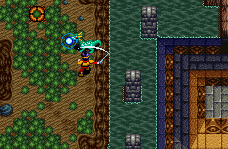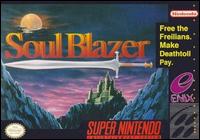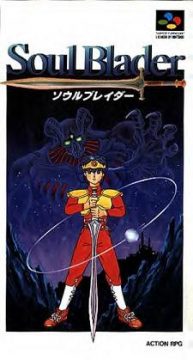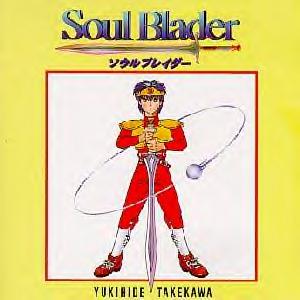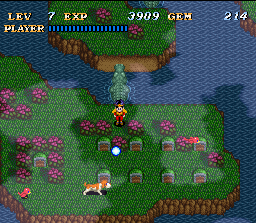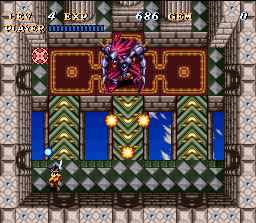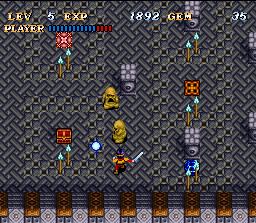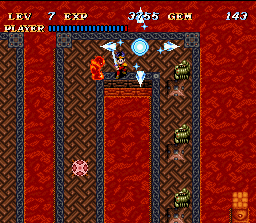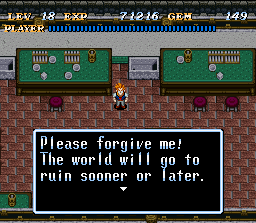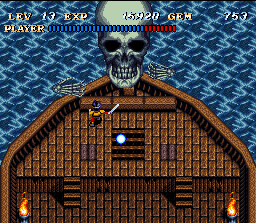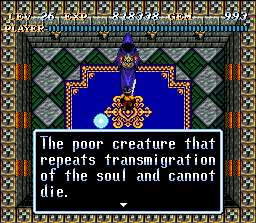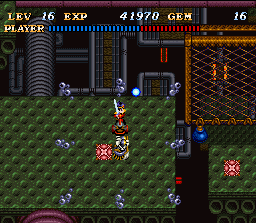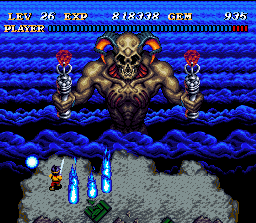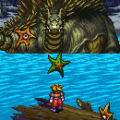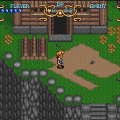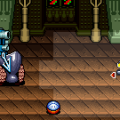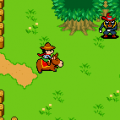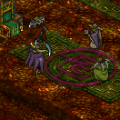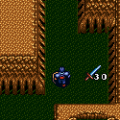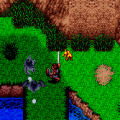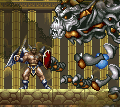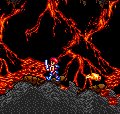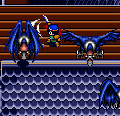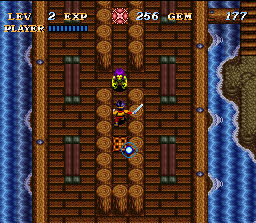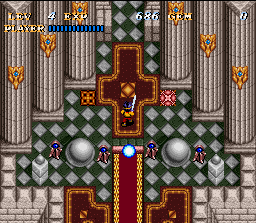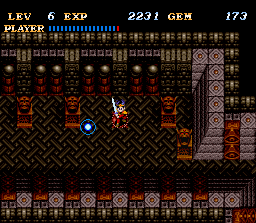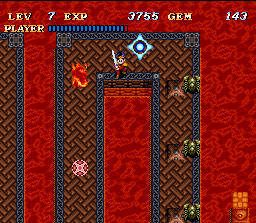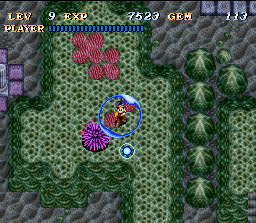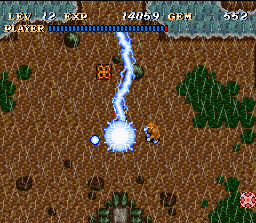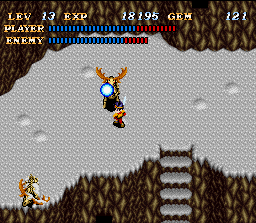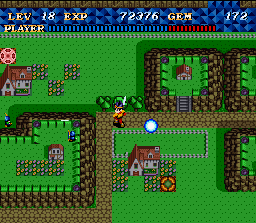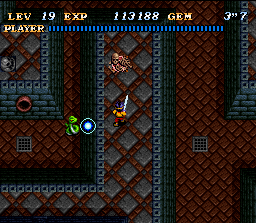One “series” that really slipped under the radar when it was released, but has since acquired a quite large fandom, is a quadrilogy of titles (often interpreted as a trilogy) that focus on death and reincarnation, directed by a company called Quintet. Quintet was founded by two former members of Falcom – programmer Masaya Mashimoto, and scenario director/game designer Tomoyoshi Miyazaki – who left during the development of Ys III. The loosely knit franchise of sorts is affectionately referred to as the Soul Blazer series, or “Gaia Trilogy”. Quintet was already responsible for what was Enix’s most beloved game that didn’t have “Dragon” or “Quest” in the title, ActRaiser. The quirky sim/action sidescroller was irresistible and garnered quite a bit of praise from Nintendo Power, EGM, and several other major publications, and was one of the best games, if not the best game available for SNES at launch.
Shortly after ActRaiser in 1990, Quintet began work on Soul Blazer, and after being released to fairly good reviews and decent attention, the series was thus created. In 1993, Quintet created Illusion of Gaia, and after a short hiatus with Robotrek, they released Terranigma (Tenchi Souzou, or “The Creation of Heaven & Earth” in Japan, which is an alternate name for the series that doesn’t quite work as well because not all of the games focus on recreating the world) in 1995. Shortly thereafter, graphic designer Koji Yokota jumped ship to form his own development house, Shade, which drafted several Quintet members onboard, including Tomoyoshi Miyazaki, and developed a fourth game which he intended to be the spiritual successor to Terranigma, The Granstream Saga. Most people aren’t even aware that Granstream is related to the loosely knit series, mainly because it doesn’t have Enix’s brand on it.
Soul Blazer is a hard game to describe. While at a glance, it’s your typical overhead-perspective action RPG, there’s a whole lot more going on with it. Much like ActRaiser before it, Soul Blazer revolves heavily around construction. Your character, a sort of pseudo-deity sent from the heavens, is charged with the task of rebuilding the world after its destruction by a demon known as Deathtoll. The world and its inhabitants were broken up into pieces and their souls trapped inside seals guarded by demons. As the hero, you must, of course, slay the demons and unseal the souls trapped inside so that the world may be restored.
The game is divided into six worlds that you will travel back and forth between at various intervals throughout the game. Each has a central town and several dungeons connected to it. When you first arrive in each world, it is completely barren, and you’ll only have access to a single area of the dungeon. As you travel through the dungeons you’ll encounter seals with monsters pouring out of them. Each seal holds a certain number of monsters, and once all of them are destroyed, you can unseal the souls trapped inside.
Each seal has some effect. Some merely open paths for you to continue deeper into the dungeon and some open up other seals. But most of the time, a seal will release the soul of an NPC in town, sometimes accompanied by a building. NPCs have all sorts of functions. Some give you items, some give you hints on what you should be doing, some unlock the entrances to other dungeons, some join you permanently as augmentations for the hero, and others are just plain useless. As you persist farther into the dungeons, you’ll release more and more souls until the town is rebuilt and repopulated.
Unfortunately, this is pretty much the formula for the entire game. And when I say formula, I mean it. The pattern is repeated religiously throughout every area, and it gets to a point where it feels like you’re doing the same thing in the same place every time, just with a different palette of colors and dogs and cats instead of people. Occasionally, when you get a new weapon or new suit of armor, you can return to a previous area and finish off monsters you couldn’t harm before, unlocking more seals and expanding on the world somewhat. Despite its formulaic approach, Soul Blazeris still pretty fun. The combat is simplistic, while retaining a slight bit of skill involvement. Pressing B makes the hero swing his sword. He swings it from left to right, but the swing lingers for a few frames as it goes to the right. This causes multiple hits to occur on targets that are on the right side of the hero’s slash, so you’ll constantly find yourself positioning the hero so that his approach on the enemy is somewhat off-center, much like the vaguely similar Ys games.
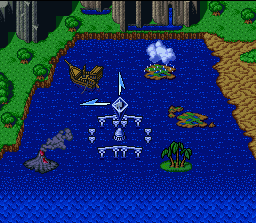 You can equip various different swords, armor and magic. Each sword usually has a special trait such as critical hits, increased item drop rate, and the ability to inflict damage on otherwise invincible foes. Each armor also has a special trait, but these are usually critical in allowing you to advance, such as the ability to breathe underwater, tolerate high temperatures, and survive the vacuum of space. Magic isn’t particularly useful. It’s required for getting at enemies that are unreachable, but other than that, you wont find yourself using it too often. Part of this is because the source of your magic, a Soul Orb, annoyingly rotates around you at high speed, making it hard to aim the trajectory of your magic shots, which cost gems dropped from enemies.
You can equip various different swords, armor and magic. Each sword usually has a special trait such as critical hits, increased item drop rate, and the ability to inflict damage on otherwise invincible foes. Each armor also has a special trait, but these are usually critical in allowing you to advance, such as the ability to breathe underwater, tolerate high temperatures, and survive the vacuum of space. Magic isn’t particularly useful. It’s required for getting at enemies that are unreachable, but other than that, you wont find yourself using it too often. Part of this is because the source of your magic, a Soul Orb, annoyingly rotates around you at high speed, making it hard to aim the trajectory of your magic shots, which cost gems dropped from enemies.
Soul Blazer‘s presentation isn’t particularly striking. The sprites can be called extremely mediocre at best. The backgrounds are usually bland and boring, but occasionally show interesting motifs, like a miniature city or a twisted, maniacal laboratory. Where the small instances of visual mastery lay is in the incredible use of Mode 7 effects; the way it was implemented in this game is quite subtle and impressive, usually just a complementary background element that somehow stands out brilliant amongst the blandness of the foreground.
90% of the sound effects in this game are ripped straight from ActRaiser. These effects were pretty lousy in that game, but they somehow seem even more out of place here. The hero makes the same deep, manly grunt as the hero from ActRaiser when he gets hit, which clashes somewhat with his young, boyish appearance. The sword slashing sound (SWIP! SWIP! SWIP!) is notoriously annoying and despised even by fans of the game.
The soundtrack is a bit…unusual. At first, it sounds like Soul Blazer uses a similar music style to ActRaiser, which would be a good thing because Yuzo Koshiro’s music in that game was pretty phenomenal. The town theme sounds eerily reminiscent of “Birth of the People”, the classic town theme from ActRaiser. But this theme is used in every town, and it quickly gets tiring. Furthermore, the dungeon themes are nothing like ActRaiser‘s. Rather than maintaining the orchestral tone of the town themes, the dungeons have this crazy ’80s synth thing going on. Some of them are slightly catchy, but others are pretty cheesy and feel out of place in comparison.
All said, Soul Blazer is a pretty fun game that sets the dark, moody, death and resurrection-themed tone that would be much more amplified by its followers
